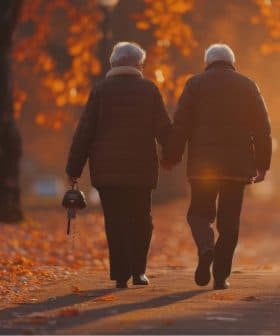Study Questions the Accuracy of Olive Tree Dating Methods
Using radiocarbon dating, researchers concluded a 1,100-year-old tree in Lebanon is the world’s oldest olive tree. Other experts believe the method may have been flawed.
 6.1K reads
6.1K readsA study in Dendrochronologia determined that a 1,100-year-old olive tree in Lebanon is the oldest living olive tree based on radiocarbon dating. Researchers noted that the common method of counting tree rings does not work for olive trees, leading to challenges in accurately dating them, with some believing the true age of the oldest olive trees cannot be determined.
A new study published in the scientific journal Dendrochronologia is making waves in the olive tree age dating community.
Researchers from the United States, Spain and Lebanon concluded that an olive tree in northern Lebanon, estimated to be approximately 1,100 years old, is the oldest living olive tree according to radiocarbon dating.
The majestic appearance of some old olive trees conveys strong feelings, and it happens quite often that monumental olive trees are also mistaken as millennia-old trees.
They added that most olive trees believed to be more than 1,000 years old have been dated incorrectly using less precise methods.
“Most monumental olive trees are centennial but not millennial, with very old trees probably restricted to harsh sites where trees show slow growth rates,” the researchers wrote.
See Also:Farmers and Officials in Jordan Work to Protect Millennial Olive TreesHowever, some scientists and historians believe numerous olive trees across the Mediterranean basin are much older. In the West Bank, Crete, Sicily or Sardinia, to name a few, one can easily find large, majestic olive trees that are often considered to be between 2,500 and 4,000 years old.
Local communities revere these trees as natural historical monuments. This reverence is due to their deep and unique integration into their regions’ social, cultural, religious and economic fabric.
The significant role played by these remarkable trees may influence a non-scientific approach to determining their age. For example, a tree that is 500 years old may easily be regarded as significantly older.
The researchers wrote, “Published age estimates indicate that most ages of old olive trees range between 200 and 700 years.”
They argue that one of the common misconceptions is the size of the world’s oldest olive trees. Large, wide trunks, imposing canopies and strong branches sprawling out in random directions give form to a wild and untamed appearance. Onlookers’ imagination about the age of such impressive creatures is easily triggered.
“The majestic appearance of some old olive trees conveys strong feelings, and it happens quite often that monumental olive trees are also mistaken as millennia-old trees,” Mauro Bernabei, a dendrochronologist at the Trees and Timber Institute of the Italian National Research Council (CNR-IVALSA), told Olive Oil Times.
“For nearly all of these olive trees, this is not the case,” he added. “However, this in no way diminishes their magnificence, historical importance, or cultural significance.”
Researchers believe olive trees might live longer than any other broadleaf species. These trees are characterized by wide, flat leaves that differ from the needle-like or scaled leaves found in conifers.
“We know of conifers living up to 4,000 years. The well-known Pinus Aristata in North America can live up to 4,800 years. When it comes to broadleaf, though, scientists tend to consider 1,000 years as an approximate limit,” Bernabei said. “The olive tree dated in Lebanon is probably reaching the very limit of broadleaf lifespan.”
“Several factors determine the size of a tree,” he added. “Examples are the environment in which the tree is located, the soil fertility, the exposition to the sun or the height of its location, and more. Among all factors influencing olive trees development, age is the one affecting it less.”
The historical method of determining the age of trees – counting the rings in the trunk – remains the most accurate way to estimate the age of many species.
“There are citations of this in the Bible; Leonardo da Vinci wrote about it; it is ancient knowledge,” Bernabei said. “All children are told that one ring for one year is the rule.”
The development of these rings and their number and dimension depend on many factors, including plant species and climate.
Tree rings allow scientific analysis to pinpoint with some precision how many years passed since the tree was born. Usually, a tree coring operation can reveal the growth rings and sustain a credible date estimate.
However, the method does not work for olive trees. “There is an issue with the olive tree, as its rings are not clearly visible,” Bernabei said. “When you look at olive wood, you can spot dark shapes which are often mistaken for rings. They are not.”
Some long-living trees, such as conifers, develop distinct rings that can be directly linked to the seasonal changes of winter and summer.
Many trees pull back all their fluids during winter in preparation for the oncoming below-freezing temperatures. This process helps prevent the expansion and freezing of liquids, which could otherwise cause significant damage to the tree.
Year after year, this self-protective behavior leaves a clear imprint on the wood’s growth process and contributes to the formation of rings.
However, olive trees — Mediterranean plants that thrive in a warmer climate — do not experience this process. Instead, dry seasons might leave ring-like marks on the olive tree, which are not particularly useful for determining the tree’s age.
“This type of ring might mean something about the different moments of a season the tree lived through but cannot tell much about the years that went by,” Bernabei said.
“The only way to observe the rings in the olive tree is to make slides, so to observe the wooden tissue at a microscopic level,” he added. “Even in that case, though, such analysis may not convey the desired results.”
Other issues in dating olive trees’ age come from their shape. “The trunk shape is rarely perfectly circular in very old trees,” Bernabei said.
“Those trees have beautiful shapes made of turnings, indentations and deformations that prevent a clear view of the wood ring,” he added. “This morphology also makes sampling complicated.”
Sampling and tree coring to date the age of a tree are carried out with specialized equipment. The process involves extracting useful tissue from different parts of the tree.
Bernabei cited previous research based on samples, showing how different samples of the same olive tree were sent to different laboratories for analysis, which yielded highly variable dating results.
“There were no two similar results, and that is due to the fact that the rings simply can’t be seen,” he said. “When it comes to olive trees, sampling is hindered by the fact that after the first external layer of five to ten centimeters, the internal portion is dry and super-hard.”
“The coring equipment cannot go farther without being broken,” he added. “If you use a driller, then it develops such heat that it burns both the sample and the internal wood.”
One method used in Lebanon, initially developed by Bernabei, involves radiocarbon dating olive tree wood.
Radiocarbon dating technology measures the amount of carbon-14 in organic material. By comparing the remaining amount of the radioactive isotope of carbon to the known time of its decay, researchers can estimate its age.
By applying these techniques to multiple samples taken from different olive trees, Bernabei estimated the age of three olive trees in the Gethsemane garden in 2015.
The challenge for dating these trees was that the tree trunks were hollow, so the central, older wood was missing. As a result of this limitation, many more trees could not even be analyzed.
“In several trees, a large void in the trunk’s center has led to it diverging into different stumps, which makes it very difficult to reconstruct the shape of each one’s basal area,” Bernabei wrote. “In the end, only three from a total of eight olive trees could be successfully dated.”
Based on his years of research, Bernabei believes it is impossible to know the true age of the world’s oldest olive trees.
He concluded, “A scientifically sound estimate of the age of olive trees cannot currently be determined.”
Share this article









